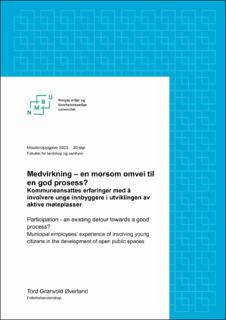| dc.contributor.advisor | Ingeborg Amalie Pedersen | |
| dc.contributor.author | Øverland, Tord Grønvold | |
| dc.date.accessioned | 2023-07-14T16:27:41Z | |
| dc.date.available | 2023-07-14T16:27:41Z | |
| dc.date.issued | 2023 | |
| dc.identifier | no.nmbu:wiseflow:6839537:54591917 | |
| dc.identifier.uri | https://hdl.handle.net/11250/3078977 | |
| dc.description.abstract | Bakgrunn: Helsetilstanden i Norge er generelt god, men helseforskjellene mellom fattige og rike øker, et fenomen kalt sosial ulikhet i helse. Studier viser at nærmiljøet er en viktig faktor i barn og unges liv, og at hvordan dette formes har stor betydning på innbyggernes helse. Studier har vist at barn og unge slutter med organisert aktivitet desto eldre de blir, men at de fortsatt har et behov for å være sosiale. For å utvikle nærmiljøet slik at barn og unge kan drive med de aktivitetene de ønsker har kommunale planleggere en viktig funksjon, og fungerer som bindeleddet mellom samfunnet muligheter og utfordringer og innbyggerne ønsker og behov.
Problemstilling: Hvilke erfaringer har kommunalt ansatte med å inkludere innbyggerne, og da særlig barn og unge, i utviklingen og planlegging av aktive møteplasser?
Metode: Det er valgt et kvalitativt forskningsdesign, og metoden for å innhente data var to fokusgruppeintervjuer med totalt syv informanter. Datamaterialet er analysert ved bruk av Braun og Clarke (2006) sin tematiske analyse, og det er benyttet hermeneutiske fortolkningsprinsipper beskrevet av Kvale og Brinkmann (2015).
Funn: Det er tre temaer overordnede temaer som informantene forteller om 1) rammenes evige tilstedeværelse, 2) planleggerens betydning for resultatet, og 3) veien til et godt anlegg. I tema 1) forteller informantene om hvordan rammer som økonomi, lovverk og føring, samt tid og kapasitet påvirker deres arbeidsvilkår. I tema 2) forteller informantene hvordan ny kunnskap endrer arbeidsmåten og rollen som planlegger, samt betydningen av å arbeide tverrfaglig i kommunal planlegging. I tema 3) forteller informantene om hvordan tid, sted og innbyggeres innspill er avgjørende for å utvikle et godt anlegg, og hvordan de ved å bruke ulike verktøy har fått bedre innsikt i målgruppens behov.
Konklusjon: Studien belyser erfaringer fra to prosjektgrupper der brukermedvirkning var en forutsetning for prosjektene. Studien viser at ved å skape gode rammer og tilrettelegge for medvirkning opplever informantene det som givende og resultatfremmende å involvere innbyggerne. | |
| dc.description.abstract | Background: The health status in Norway is generally good, but the health inequalities between the rich and the poor are increasing, a phenomenon known as social inequality in health. Studies have shown that the local environment is an important factor in the lives of children and young people, and how this is shaped has a significant impact on the health of the population. Studies have also shown that children and young people tend to stop organized activities as they get older, but still have a need for social interaction. Municipal planners play an important role in developing the local environment so that children and young people can engage in the activities they want, acting as a link between the opportunities and challenges of society and the desires and needs of the residents.
Aim: What experiences do municipal employees have with including citizens, especially children and young people, in the development and planning of open public places?
Method: A qualitative research design was chosen, and the method for data collection was two focus group interviews with a total of seven informants. The data material was analyzed using Braun and Clarke's (2006) thematic analysis, and hermeneutic principles of interpretation described by Kvale and Brinkmann (2015) were utilized.
Findings: There are three main themes that the informants discuss: 1) the constant presence of frameworks, 2) the importance of the planner for the outcome, and 3) the path to a good facility. In theme 1), the informants discuss how frameworks such as economy, legislation, and guidelines, as well as time and capacity, affect their working conditions. In theme 2), the informants describe how new knowledge changes their working methods and the role of the planner, as well as the importance of working cross-functionally in municipal planning. In theme 3), the informants discuss how time, place, and feedback from residents are crucial to developing a good facility, and how using different tools has provided them with better insights into the target group's needs.
Conclusion: The study sheds light on the experiences of two project groups where user involvement was a prerequisite for the projects. The study shows that by creating good frameworks and facilitating user involvement, the informants find it rewarding and effective to involve residents in the planning process. | |
| dc.language | nob | |
| dc.publisher | Norwegian University of Life Sciences | |
| dc.title | Medvirkning – en morsom omvei til en god prosess? Kommuneansattes erfaringer med å involvere unge innbyggere i utviklingen av aktive møteplasser | |
| dc.type | Master thesis | |
